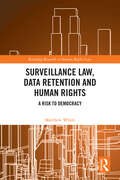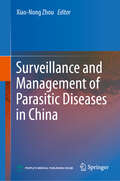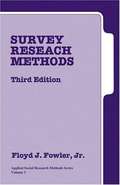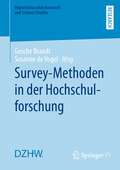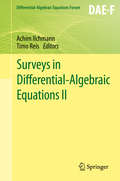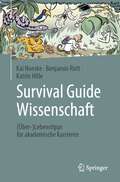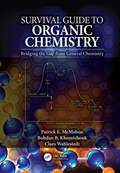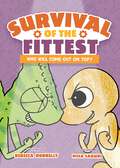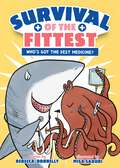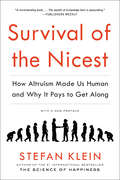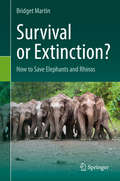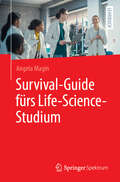- Table View
- List View
Surrounded by Science: Learning Science in Informal Environments
by National Research CouncilPractitioners in informal science settings--museums, after-school programs, science and technology centers, media enterprises, libraries, aquariums, zoos, and botanical gardens--are interested in finding out what learning looks like, how to measure it, and what they can do to ensure that people of all ages, from different backgrounds and cultures, have a positive learning experience. Surrounded by Science: Learning Science in Informal Environments, is designed to make that task easier. Based on the National Research Council study, Learning Science in Informal Environments: People, Places, and Pursuits, this book is a tool that provides case studies, illustrative examples, and probing questions for practitioners. In short, this book makes valuable research accessible to those working in informal science: educators, museum professionals, university faculty, youth leaders, media specialists, publishers, broadcast journalists, and many others.
Surrounded by Science: Learning Science in Informal Environments
by National Research Council of the National AcademiesPractitioners in informal science settings--museums, after-school programs, science and technology centers, media enterprises, libraries, aquariums, zoos, and botanical gardens--are interested in finding out what learning looks like, how to measure it, and what they can do to ensure that people of all ages, from different backgrounds and cultures, have a positive learning experience. Surrounded by Science: Learning Science in Informal Environments, is designed to make that task easier. Based on the National Research Council study, Learning Science in Informal Environments: People, Places, and Pursuits, this book is a tool that provides case studies, illustrative examples, and probing questions for practitioners. In short, this book makes valuable research accessible to those working in informal science: educators, museum professionals, university faculty, youth leaders, media specialists, publishers, broadcast journalists, and many others.
Surroundings: A History of Environments and Environmentalisms
by Etienne S. BensonGiven the ubiquity of environmental rhetoric in the modern world, it’s easy to think that the meaning of the terms environment and environmentalism are and always have been self-evident. But in Surroundings, we learn that the environmental past is much more complex than it seems at first glance. In this wide-ranging history of the concept, Etienne S. Benson uncovers the diversity of forms that environmentalism has taken over the last two centuries and opens our eyes to the promising new varieties of environmentalism that are emerging today. Through a series of richly contextualized case studies, Benson shows us how and why particular groups of people—from naturalists in Napoleonic France in the 1790s to global climate change activists today—adopted the concept of environment and adapted it to their specific needs and challenges. Bold and deeply researched, Surroundings challenges much of what we think we know about what an environment is, why we should care about it, and how we can protect it.
Surveillance Law, Data Retention and Human Rights: A Risk to Democracy (Routledge Research in Human Rights Law)
by Matthew WhiteThis book analyses the compatibility of data retention in the UK with the European Convention on Human Rights (ECHR). The increase in the use of modern technology has led to an explosion of generated data and, with that, a greater interest from law enforcement and intelligence agencies. In the early 2000s, data retention laws were introduced into the UK, and across the European Union (EU). This was met by domestic challenges before national courts, until a seminal ruling by the Court of Justice in the European Union (CJEU) ruled that indiscriminate data retention was incompatible with EU law. Since then, however, the CJEU has revised its position and made certain concessions, particularly under the guise of national security. This book focuses on data retention in the UK with the principal aim of examining compatibility with the ECHR. This is explored through a variety of ways including providing an account of democracy and why secret surveillance poses a threat to it, a history of data retention, assessing the seriousness that data retention poses to fundamental rights, the collection of rights that are affected by data retention which are crucial for a functioning democracy, the implications of who can be obligated to retain (and what to retain), the idea that data retention is a form of surveillance and ultimately, with all things considered, whether this is compatible with the ECHR. The work will be an invaluable resource for students, academics, researchers and policy-makers working in the areas of privacy, human rights law and surveillance.
Surveillance and Management of Parasitic Diseases in China
by Xiao-Nong ZhouThis book intends to share the lessons and experiences learnt from the Chinese parasitic diseases control programme to the professionals, policy makers and researchers from other disease endemic countries. Especially, those lessons on surveillance and response have been well distilled at national level in China, where some of parasitic diseases have been and going to be eliminated, e.g. lymphatic filariasis, malaria, schistosomiasis. The book covers the concept and technologies on surveillance and response to endemic and outbreaks of parasitic diseases, as well as relevant case management and data handling. The book includes three main parts. The first part consists of general chapters, which covers the general information on parasitic disease surveillance, the classification and application of surveillance technologies, etc. The second part of chapters cover surveillance technologies on parasites distribution, infections patterns in a region, related vectors, ecological environment elements, and the early warning and response, etc. In the third part of chapters, the concepts, methods, operating procedures, data collection, result analysis, reports and conclusions of various surveillance technologies in detail, along with the examples and guidelines of surveillance and management for parasitic infections are included. The book is likely to be of interest to the world-wide professionals, practitioners, managers and policy makers in governments or industry in the field of infectious diseases control.
Survey Research Methods
by Floyd J. Fowler Jr.Popular with those who want to collect, analyze, or read about survey data this book provides a sound basis for evaluating how each aspect of a survey can affect its precision, accuracy and credibility. Coverage includes: Improved techniques for evaluating survey questions, the latest options available to researchers in using the computer and the Internet for surveys, recent methodological findings to enhance survey research.
Survey of Chemical Spill Countermeasures
by Merv Fingas Jennifer Charles P. G. Langille L. B. SolsbergUntil now, information regarding chemical spill clean-up was available only through manufacturer's literature from an individual firm, or scattered in the traditional textbooks on remediation engineering and hazardous waste management. Survey of Chemical Spill Countermeasures provides a one-stop source of information on how to clean up spill sites in safe, acceptable ways. Because of the ever-growing need to maintain constant vigilance over hazardous chemicals and potential leaks and spills, this reference will become an important source for the practicing environmental engineer and field technician.Survey of Chemical Spill Countermeasures provides operators with useful information on how to clean up sites, including controlling leakage, containment of spills on land and water, and ways to safely transfer and store the contaminants. Additionally, the book includes up-to-date information on containment and treatment technologies, from dredging and vacuuming, to solid and vapor treatment systems.
Survey-Methoden in der Hochschulforschung (Higher Education Research and Science Studies)
by Gesche Brandt Susanne De VogelViele (Erhebungs-)Projekte in der Hochschulforschung bringen neue Erkenntnisse aus dem Bereich der Survey Methodology hervor. Damit Forschende von dieser Expertise profitieren und sie für die Optimierung ihrer Befragungspraxis nutzen können, werden die Ergebnisse in diesem Sammelband zusammengebracht. Vorgestellt werden Beiträge zum Thema Rekrutierung und Incentivierung, Survey Design und Mixed Devices, Instrumentenentwicklung, Panel Attrition und Non-Response sowie internationale Befragungen. Der Fokus liegt dabei auf den besonderen Herausforderungen, die die Erforschung Hochqualifizierter für die Durchführung quantitativer Studien mit sich bringt.
Surveying the Skies
by Gareth Wynn-WilliamsSince the time of Galileo, astronomy has been driven by technological innovation. With each major advance has come the opportunity and enthusiasm to survey the sky in a way that was not possible before. It is these surveys of discovery that are the subject of this book. In the first few chapters the author discusses what astronomers learned from visible-light surveys, first with the naked eye, then using telescopes in the seventeenth century, and photography in the nineteenth century. He then moves to the second half of the twentieth century when the skies started to be swept by radio, infrared, ultraviolet, x-ray and gamma ray telescopes, many of which had to be flown in satellites above the Earth's atmosphere. These surveys led to the discovery of pulsars, quasars, molecular clouds, protostars, bursters, and black holes. He then returns to Earth to describe several currently active large-scale projects that methodically collect images, photometry and spectra that are then stored in vast publicly-accessible databases. Dr. Wynn-Williams also describes several recent "microsurveys" - detailed studies of small patches of sky that have led to major advances in our understanding of cosmology and exoplanets.
Surveys in Differential-Algebraic Equations I
by Achim Ilchmann Timo ReisThe need for a rigorous mathematical theory for Differential-Algebraic Equations (DAEs) has its roots in the widespread applications of controlled dynamical systems, especially in mechanical and electrical engineering. Due to the strong relation to (ordinary) differential equations, the literature for DAEs mainly started out from introductory textbooks. As such, the present monograph is new in the sense that it comprises survey articles on various fields of DAEs, providing reviews, presentations of the current state of research and new concepts in - Controllability for linear DAEs - Port-Hamiltonian differential-algebraic systems - Robustness of DAEs - Solution concepts for DAEs - DAEs in circuit modeling. The results in the individual chapters are presented in an accessible style, making this book suitable not only for active researchers but also for graduate students (with a good knowledge of the basic principles of DAEs) for self-study.
Survival Guide Wissenschaft: (Über-)Lebenstipps für akademische Karrieren
by Benjamin Rott Katrin Hille Kai NoeskeSurvival Guide Wissenschaft – der unverzichtbare Begleiter für angehende Wissenschaftler:innen! Wertvolle Ratschläge, bewährte Strategien und Insiderwissen aus vielen Jahrzehnten akademischer Laufbahnen mit Kurven, Ecken und Kanten. Tipps und Tricks, Dos and Don’ts, um wissenschaftliche Karrieren an Universitäten und anderen Forschungseinrichtungen zu starten, zu überleben und erfolgreich voranzutreiben. Von der Forschungsplanung bis zur Bewerbung um Stipendien und Stellen, von der Netzwerkbildung bis zur Work-Life-Balance, aber auch Exit-Strategien – dieser Survival Guide liefert die entscheidenden (Über-)Lebenstipps für ein Leben in Academia.
Survival Guide to General Chemistry: Bridging The Gap From General Chemistry
by Patrick E. McMahon Rosemary McMahon Bohdan KhomtchoukThis work evolved over thirty combined years of teaching general chemistry to a variety of student demographics. The focus is not to recap or review the theoretical concepts well described in the available texts.Instead, the topics and descriptions in this book make available specific, detailed step-by-step methods and procedures for solving the major types of problems in general chemistry. Explanations, instructional process sequences, solved examples and completely solved practice problems are greatly expanded, containing significantly more detail than can usually be devoted to in a comprehensive text. Many chapters also provide alternative viewpoints as an aid to understanding. Key Features: The authors have included every major topic in the first semester of general chemistry and most major topics from the second semester. Each is written in a specific and detailed step-by-step process for problem solving, whether mathematical or conceptual Each topic has greatly expanded examples and solved practice problems containing significantly more detail than found in comprehensive texts Includes a chapter designed to eliminate confusion concerning acid/base reactions which often persists through working with acid/base equilibrium Many chapters provide alternative viewpoints as an aid to understanding This book addresses a very real need for a large number of incoming freshman in STEM fields
Survival Guide to Organic Chemistry: Bridging the Gap from General Chemistry
by Bohdan B. Khomtchouk Claes Wahlestedt Patrick E. McMahonThe Survival Guide to Organic Chemistry: Bridging the Gap from General Chemistry enables organic chemistry students to bridge the gap between general chemistry and organic chemistry. It makes sense of the myriad of in-depth concepts of organic chemistry, without overwhelming them in the necessary detail often given in a complete organic chemistry text. Here, the topics covered span the entire standard organic chemistry curriculum. The authors describe subjects which require further explanation, offer alternate viewpoints for understanding and provide hands-on practical problems and solutions to help master the material. This text ultimately allows students to apply key ideas from their general chemistry curriculum to key concepts in organic chemistry.
Survival Of The Fittest: The Anatomy of Peak Physical Performance
by Mike StroudDiscover the secrets of how to perform at your best in 2019In this fascinating book based soundly in medical science, Mike Stroud - of BBC Television's The Challenge and SAS: Are You Tough Enough? - sets out the genetics, diet and exercise that enable humans to perform at their peak. Dr Stroud - polar explorer, practising hospital physician, and a former adviser to the Ministry of Defence - analyses individual feats of survival and athletic prowess that illustrate the way the body functions at its best. He dissects his own challenging experiences of crossing Antarctica with Ranulph Fiennes, running marathons in the Sahara and participating in gruelling cross-country endurance races in the United States and gives some tips on how to stay fit for life for those of us who find walking the dog an endurance challenge...This revised edition includes the story of Dr Stroud and Sir Ranulph Fiennes' incredible 2003 global marathon challenge - seven marathons on seven continents in seven days - in aid of the British Heart Foundation.'The ultimate sporting diet documented in mouth-watering detail' The Times
Survival Strategies in Cold-adapted Microorganisms
by Reeta Goel Ravindra Soni Deep Chandra Suyal Mahejibin KhanExtremophiles have unique physiological properties, thus considered to be ideal candidates for industrial development. This book present concepts on cold-adapted microorganisms, centered on four different aspects - (i) diversity of cold adapted microbes (ii) their ecology, physiology and metabolism (iii) omics research in the field and (iv) their potential applications. This volume collates the recent developments and innovations with respect to these microorganisms. This book is meant for researchers, biochemists, industries, and government agencies interested in cold active microbes and their products. Also, would be of interest to NGOs and progressive farmers which are working for higher altitude ecosystems throughout the globe.
Survival Strategies in Extreme Cold and Desiccation: Adaptation Mechanisms And Their Applications (Advances in Experimental Medicine and Biology #1081)
by Mari Iwaya-Inoue Minoru Sakurai Matsuo UemuraThis book comprehensively describes biological phenomena, adaptation mechanisms, and strategies of living organisms to survive under extremely cold or desiccated conditions at molecular, cellular, and organ levels. It also provides tremendous potential for applications of the findings to a wide variety of industries. The volume consists of three parts: Part 1, Adaptation Mechanisms of Cold, and Part 2, Adaptation Mechanisms of Desiccation, collect up-to-date research on mechanisms and strategies of living organisms such as sleeping chironomids, polar marine fishes, hibernating mammals, bryophytes, dormant seeds, and boreal plants to survive under extreme cold and desiccated conditions at molecular, cellular, and organ levels. Part 3, Application Technologies from Laboratory to Society, covers various applications to a wide variety of industries such as the medical, food, and agricultural and life science industries. For example, biological knowledge of how plants and animals survive under cold, drought, and desiccated conditions may provide a hint on how we can improve crop production in a very fragile environment in global climate change. Unique molecules that protect cells during desiccation and freezing such as trehalose and antifreeze protein (AFP) have potential for use to preserve cells, tissues, and organs for the long term under very stable conditions. In addition, the current progress of supercooling technology of cells may lead us to solve problems of cellular high sensitivity to freezing injury, which will dramatically improve the usability of these cells. Furthermore, knowledge of water substitution and glass formation as major mechanisms for formulation designs and new drying technologies will contribute to the development of food preservation and drug delivery systems under dry conditions. Written by contributors who have been conducting cutting-edge science in related fields, this title is recommended to a wide variety of readers who are interested in learning from such organisms their strategies, mechanisms, and applications, and it will inspire researchers in various disciplines.
Survival Strategies: Cooperation and Conflict in Animal Societies
by Raghavendra GadagkarDid you know that Tasmanian hens have two husbands? That cellular slime molds commit suicide? That vampire bats will share food with hungry fellow bats and that hanuman langurs commit infanticide? Why creatures great and small behave in such fascinating and seemingly perplexing ways is explained in this delightful account of the evolutionary foundations of animal social behavior. Only in recent years have biologists and ethologists begun to apply careful evolutionary thinking to the study of animal societies--and with spectacular results. This book presents the choicest of these findings, with a remarkable wealth of insights into the myriad strategies that animals have developed to perpetuate their kind. In an irresistible style, Raghavendra Gadagkar explores the strategies of cooperation and conflict adopted by animals--from the lordly lion to the primitive wasp worker--as they choose mates, raise their young, communicate with others, and establish the division of labor necessary to feed and protect the group and safeguard their territory. Whether focusing on the birds or the bees, this book offers both superb descriptions and lucid explanations of many different behaviors encountered in the animal world: why a ground squirrel will sound an alarm--even risk its own safety--to warn fellow squirrels of impending danger; why weaver ant larvae donate silk for nest building; why house mice raise their offspring in a communal nursery; and how animals can recognize the relatives they want to favor--or avoid. Illustrated with both photographs and explanatory diagrams, this expert and inviting tour of the social world of animals will inform and charm anyone curious about the motivations behind the amazing range of activity in the animal kingdom.
Survival and Sacrifice in Mars Exploration
by Erik SeedhouseWith current technology, a voyage to Mars and back will take three years. That's a lot of time for things to go wrong. But sooner or later a commercial enterprise will commit itself to sending humans to Mars. How will the astronauts survive? Some things to consider are: ith current technology, a voyage to Mars and back will take three years. That's a lot of time for things to go wrong. But sooner or later a commercial enterprise will commit itself to sending humans to Mars. How will the astronauts survive? Some things to consider are: * Who decides what medical resources are used for whom? Who decides what medical resources are used for whom? * What is the relative weight of mission success and the health of the crew? What is the relative weight of mission success and the health of the crew? * Do we allow crewmembers to sacrifi ce their lives for the good of the mission? Do we allow crewmembers to sacrifi ce their lives for the good of the mission? * And what if a crewmember does perish? Do we store the body for return to Earth or give the member a burial in space? Questions like these, and hundreds of others, have been explored by science fi ction, but scant attention has been paid by those designing missions. Fortunately, the experience gained in polar exploration more than 100 years ago provides crews and mission planners with a framework to deal with contingencies and it is this that forms the core of this book. Why the parallels between polar and space exploration? Because polar exploration offers a better analogy for a Mars mission today than those invoked by the space community. Although astronauts are routinely compared to Lewis and Clark, Mars-bound astronauts will be closer in their roles to polar explorers. And, as much as space has been described as a New Frontier, Mars bears greater similarity to the polar regions, which is why so much can be learned from those who ventured there. And what if a crewmember does perish? Do we store the body forreturn to Earth or give the member a burial in space? Questions like these, and hundreds of others, have been explored by science fi ction, but scant attention has been paid by those designing missions. Fortunately, the experience gained in polar exploration more than 100 years ago provides crews and mission planners with a framework to deal with contingencies and it is this that forms the core of this book. Why the parallels between polar and space exploration? Because polar exploration offers a better analogy for a Mars mission today than those invoked by the space community. Although astronauts are routinely compared to Lewis and Clark, Mars-bound astronauts will be closer in their roles to polar explorers. And, as much as space has been described as a New Frontier, Mars bears greater similarity to the polar regions, which is why so much can be learned from those who ventured there.
Survival and Sustainability
by James W. Lamoreaux Umut Türker Hüseyin GökçekusThe International Conference on Environment: Survival and Sustainability, held at the Near East University, Nicosia, Northern Cyprus 19-24 February 2007, dealt with environmental threats and proposed solutions at all scales. The 21 themes addressed by the conference fell into four broad categories; Threats to Survival and Sustainability; Technological Advances towards Survival and Sustainability; Activities and Tools for Social Change; Defining Goals for Sustainable Societies. Activities and tools that move the society towards greater sustainability were emphasized at the conference. These included environmental law and ethics, environmental knowledge, technology and information systems, media, environmental awareness, education and lifelong learning, the use of literature for environmental awareness, the green factor in politics, international relations and environmental organizations. The breadth of the issues addressed at the conference made clear the need for greatly increased interdisciplinary and international collaboration the survival and sustainability concept. The exchanges at the conference represent a step in this direction.
Survival of the Fittest (Survival of the Fittest #1)
by Rebecca DonnellyIn this high-interest full-color graphic novel chapter book, embark on an engineering extravaganza and discover all that animals can do in a science competition!7 fierce animal competitors2 shark judges1 winnerWho will come out on top?Survival of the Fittest: the game show where animal contestants pitch the latest and greatest in scientific innovation to a panel of shark judges! Animals of all sizes and skills compete to see who can come up with the most useful, most creative, most brilliant design for a product based on something that exists in the natural world. Today's theme is: engineering.Filled with interesting information, awesome visuals, and funny dialogue, this new series by nonfiction maven Rebecca Donnelly is Shark Tank made literal. Swim along - and try not to get chomped by the Chomp! Buzzer.
Survival of the Fittest: Who's Got the Best Medicine? (Survival of the Fittest)
by Rebecca DonnellyIn this second installment of this full-color graphic novel chapter book, explore medical marvels and discover all that animals can do in a science competition!Welcome back to Survival of the Fittest! Here, animals of all sizes and skills compete to see who can come up with the most useful and clever design for a product based on something in the natural world. Today’s theme is: Medical Marvels!Dive in with Mosquito, Sea Urchin, Octopus, and more as they present inventions inspired by their own unique anatomy. From sticky suction cups to water-repellent skin, who will impress the sharks the most?
Survival of the Friendliest: Understanding Our Origins and Rediscovering Our Common Humanity
by Brian Hare Vanessa WoodsA powerful new theory of human nature suggests that our secret to success as a species is our unique friendliness&“Brilliant, eye-opening, and absolutely inspiring—and a riveting read. Hare and Woods have written the perfect book for our time.&”—Cass R. Sunstein, author of How Change Happens and co-author of Nudge For most of the approximately 300,000 years that Homo sapiens have existed, we have shared the planet with at least four other types of humans. All of these were smart, strong, and inventive. But around 50,000 years ago, Homo sapiens made a cognitive leap that gave us an edge over other species. What happened? Since Charles Darwin wrote about &“evolutionary fitness,&” the idea of fitness has been confused with physical strength, tactical brilliance, and aggression. In fact, what made us evolutionarily fit was a remarkable kind of friendliness, a virtuosic ability to coordinate and communicate with others that allowed us to achieve all the cultural and technical marvels in human history. Advancing what they call the &“self-domestication theory,&” Brian Hare, professor in the department of evolutionary anthropology and the Center for Cognitive Neuroscience at Duke University and his wife, Vanessa Woods, a research scientist and award-winning journalist, shed light on the mysterious leap in human cognition that allowed Homo sapiens to thrive. But this gift for friendliness came at a cost. Just as a mother bear is most dangerous around her cubs, we are at our most dangerous when someone we love is threatened by an &“outsider.&” The threatening outsider is demoted to sub-human, fair game for our worst instincts. Hare&’s groundbreaking research, developed in close coordination with Richard Wrangham and Michael Tomasello, giants in the field of cognitive evolution, reveals that the same traits that make us the most tolerant species on the planet also make us the cruelest. Survival of the Friendliest offers us a new way to look at our cultural as well as cognitive evolution and sends a clear message: In order to survive and even to flourish, we need to expand our definition of who belongs.
Survival of the Nicest: How Altruism Made Us Human and Why It Pays to Get Along
by Stefan KleinAward-winning, international bestselling science writer Stefan Klein explores the benefits of altruism on humanity in Survival of the Nicest.The phrase “survival of the fittest” conjures an image of the most cutthroat individuals rising to the top. But Stefan Klein, author of The Science of Happiness, makes the startling assertion that altruism is the key to lasting personal and societal success. In fact, altruism defines us: Natural selection favored those early humans who cooperated in groups, and with survival more assured, our altruistic ancestors were free to devote brainpower to developing intelligence, language, and culture—our very humanity. Klein’s groundbreaking findings lead him to a vexing question: If we’re really hard-wired to act for one another’s benefit, why aren’t we all getting along? He believes we’ve learned to mistrust our instincts because success is so often attributed to selfish ambition, and with an extraordinary array of material—current research on genetics and the brain, economics, social psychology, behavioral and anthropological experiments, history, and modern culture—he makes the case that generosity for its own sake remains the best way to thrive.“Stefan Klein, an enticing storyteller, marshals the evidence for the value of altruism—not only to one’s family but, much more interestingly, to one’s self and one’s tribe. Altruism is truly contagious!” —Roald Hoffman, Nobel Laureate“A scholarly tour de force about why generosity makes good sense, Survival of the Nicest is also compulsively readable. Klein argues convincingly that helping others is one of the best things we can do for ourselves.” —Elizabeth Svoboda, author of What Makes a Hero?: The Surprising Science of Selflessness
Survival or Extinction?: How to Save Elephants and Rhinos
by Bridget MartinWritten with passion for anyone interested in seeing an end to the illegal trade in elephant ivory and rhino horn, this book shows how, by working together, people all over the world who care about these animals are gradually bringing about change for the better. It takes an overview of how the current situation came to pass by exploring poaching and its devastating consequences and the pivotal role of organized crime. The discussion of how matters are starting to improve covers the investigation and monitoring of ivory markets, sustainable uses and the key role of local communities.Enforcement of the law is vital in this story. Enter the enforcers, the technology they use to defeat the poachers and the evidence they require to prosecute offenders. Cases, some deeply shocking, are included, as well as a number of fascinating case studies, while the exploits of organized crime gangs make lively, as well as disturbing reading. Throughout the message is clear. We can and must save these animals from extinction.
Survival-Guide fürs Life-Science-Studium
by Angela MaginDu planst ein Studium im Bereich Biomedizin, Molekularbiologie, Life Sciences und Co. oder hast gerade angefangen zu studieren – und hast viele Fragen? Vor allem dazu, was in deinem Studium auf dich zukommt? Hier erfährst du, was an der Hochschule von dir erwartet wird! Von deinen ersten Schritten ins Labor über die Auswertung von Daten, das Verfassen von Praktikumsprotokollen und die Arbeit mit wissenschaftlicher Literatur bis hin zu deinem eigenen, kleinen Forschungsprojekt in der Abschlussarbeit begleitet dich dieses Buch durch dein gesamtes Studium. Es zeigt dir, worauf du besonders achten musst, und erklärt dir das, was in deinen Vorlesungen oft zu kurz kommt: Wie Wissenschaft in der Praxis funktioniert.



